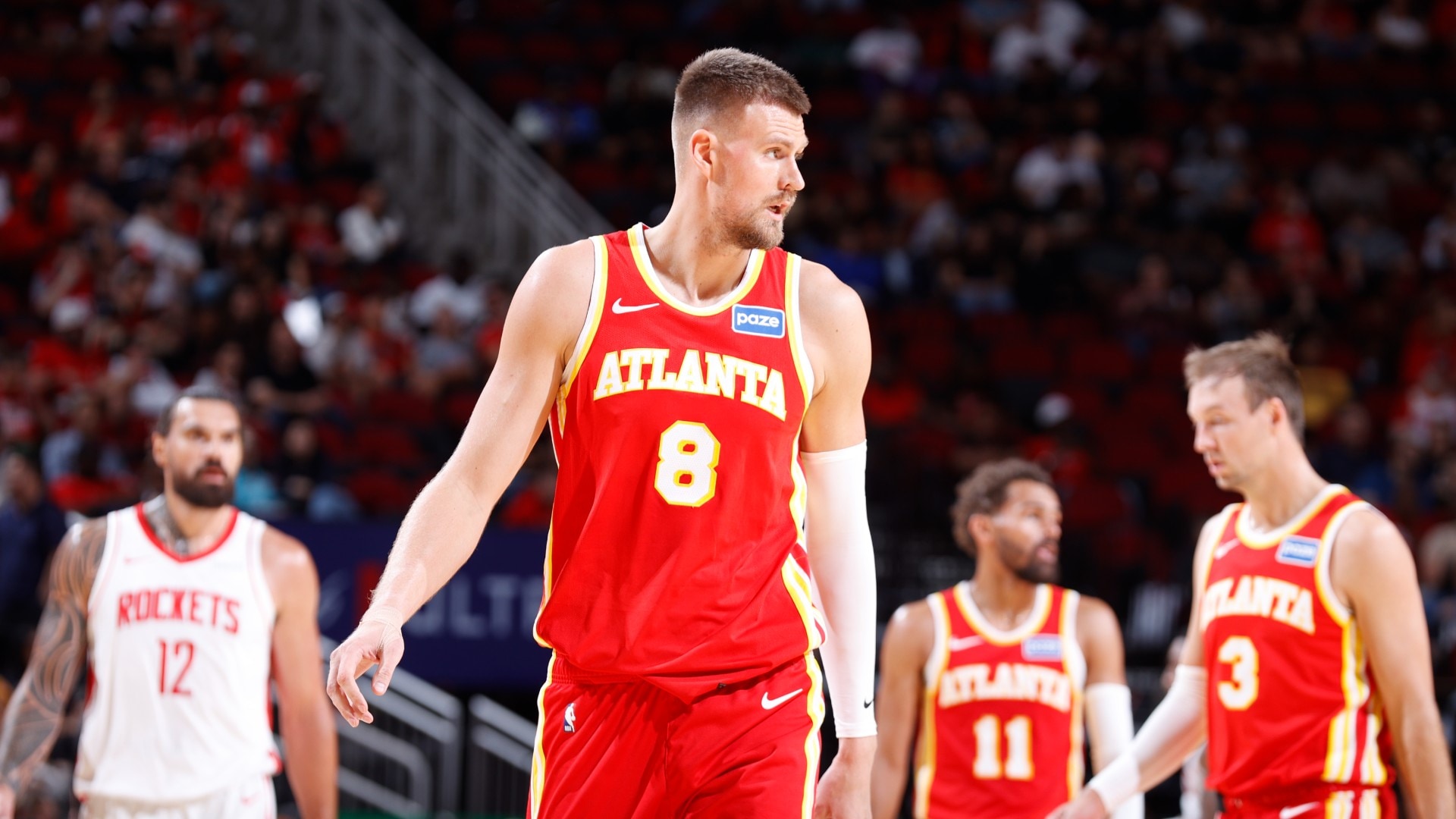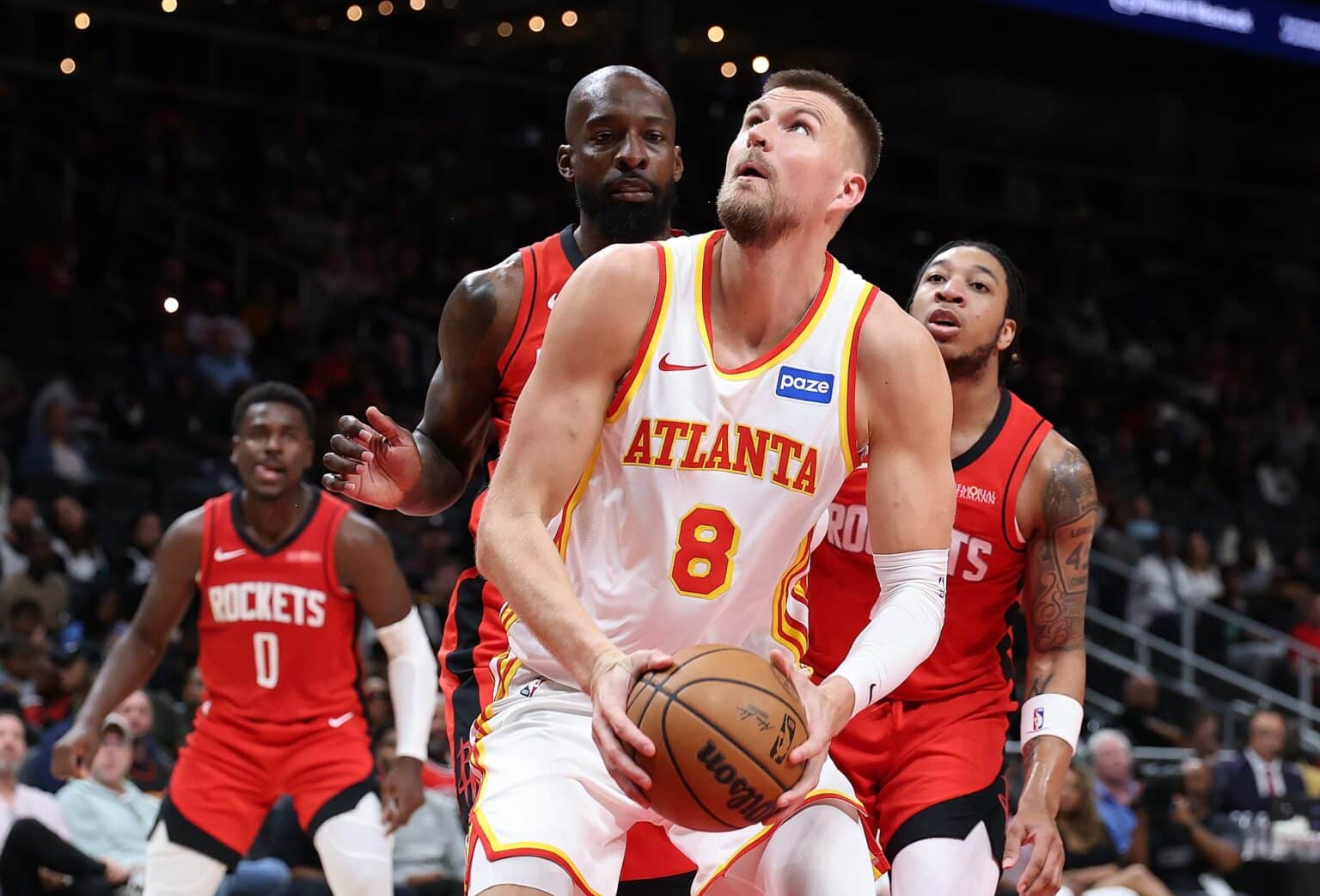
Editor’s Note: Read more NBA coverage from The Athletic here. The views on this page do not necessarily reflect the views of the NBA or its teams.
***
ATLANTA — Sitting on the trade block is no different from waiting on a slew of text messages. On the morning of June 25, Kristaps Porziņģis woke up to an onslaught of them.
This was the tell-tale sign. Porziņģis was no longer a member of the Boston Celtics, a moment he understood was inevitable. The Celtics’ teardown, thanks to injuries and untenable finances, was afoot. Porziņģis’ exit would be one consequence.
Home in his native Latvia, Porziņģis reached for his phone to open a group chat with his buddies, assuming they would be discussing his new squad there. But instead of any breaking news tweet, he saw three bird emojis.
Things were getting weird.
“I was like, ‘Eagles? What is this?’” Porziņģis recalled in a recent conversation with The Athletic. “And then I was like, ohhhhh, the Hawks. Interesting.”
Interesting is one way to put it.
Porziņģis’ agent had kept him abreast of the Celtics’ negotiations with other teams. Three organizations (the LA Clippers, San Antonio Spurs and Phoenix Suns) were on the radar. The Hawks were nowhere near it.
Atlanta had called Boston only a day earlier to make the offer. It moved around money. The deal came together quickly. Now, Porziņģis begins a new stage of his career on a team that’s in transition, too.
The Hawks, behind a renovated front office and roster, begin their most anticipated season in years when they open against the Toronto Raptors on Wednesday. Most projections place them above — some well above — the Play-In Tournament, a stage they’ve been unable to avoid for nearly half a decade. Their flashiest addition is the 7-foot-3 Porziņģis, a sweet-shooting, rim-protecting big man capable of changing the geometry of a team.
That is, as long as he is himself.
Entering the final year of his contract, Porziņģis is hoping to prove his impact once again.
He banged in 3-pointers, deterred drivers and dominated the post during 42 regular-season games in Boston last season, but a mysterious illness zapped him of his energy in the playoffs. Come the second round, he couldn’t run for long stints. At no point did he resemble the two-way star who had helped the Celtics to a title the season prior.
“It hit me, and it hit me like a truck,” Porziņģis said. “The breathing wasn’t good. I did everything I could potentially to feel as good as I could, but my engine wasn’t running the way I wanted.”
He scored only 25 total points during a six-game Eastern Conference semifinals loss after averaging more than 19 during the regular season.
Doctors later diagnosed him with postural orthostatic tachycardia syndrome, he said, more commonly referred to as POTS, an autonomic condition that can dramatically increase a patient’s heart rate when standing up instead of spread horizontal. Handled wrong — or not yet diagnosed — and POTS can lead to extreme exhaustion or dizziness.
In his worst moments, Porziņģis’ heart rate could stabilize while he was lying down, but the act of standing up could rev it to 130 beats per minute.
“You know how people say, ‘Oh, I’m so fatigued.’ I’ve never used those words. I don’t even like to speak in those terms, but I really was like that,” Porziņģis said. “At that time, I could just lay on the couch and be a house cat.”
Today, Porziņģis is on a mission to prove he has the zoomies.
He is eligible for a contract extension, though he said he is in no rush to sign one. Instead, he’d like to prove that his playoff performance was merely a one-off. Post-diagnosis, Porziņģis and his doctors know how to manage POTS — and it’s without the need for any special medication. A high-salt diet and a more regimented non-basketball resting schedule is a must.
He played with the Latvian national team during Eurobasket this summer without issue. He’s likely to start for Atlanta, displacing the former first-string center, Onyeka Okongwu, a 24-year-old up-and-comer who played his best ball ever to close last season.
Porziņģis is in a new place — but then again, so are the Hawks.
The Hawks’ first call to acquire Porziņģis wasn’t to the Celtics. To piecemeal the salaries necessary to land the center, they wanted to move Terrence Mann, a wing with three more years remaining on his contract. They knew Boston — heading into at best a gap year and at worst a rebuild — wouldn’t take back such a financial commitment.
This trade had to be a multi-teamer.
So the Hawks rang the Brooklyn Nets, one of the few teams with cap space. The cost of sending three years of Mann to Brooklyn was the No. 22 pick in the draft, one that the front office deemed acceptable since it also owned the 13th selection. The Hawks were already young and figured that too much inexperience at once could make developing talent more difficult.
Within a day, Atlanta had an agreement. The Hawks, coming off a 40-42 season, would send out Mann, Georges Niang, the No. 22 pick and a second-rounder for Porziņģis’ expiring contract, figuring if it didn’t work, they could save money in the long term — and if it did, they could acquire a rare type of talent, a big man who could drain 3s and block shots.
The idealized version of Porziņģis fits anywhere. But he is even cozier alongside the Hawks’ four-time All-Star point guard, Trae Young, a ludicrous passer and high-paced scorer whose defense requires a teammate or four on the back line to clean up mistakes.
The Hawks are toeing a line, trying to vault into another tier of the Eastern Conference while also minding the future. New general manager Onsi Saleh, who took over as the team’s lead executive in April, came up with the San Antonio Spurs, a franchise that cares less about opening couple-year windows and more about building sustainable futures. Saleh wants to carry that philosophy to Atlanta, which has executed quick-fix moves in its recent history.
Just after trading for Porziņģis, the Hawks pulled off the swap of the draft, flipping the No. 13 pick to the New Orleans Pelicans for No. 23 and an unprotected 2026 first-rounder, which has a chance to be close to the top if New Orleans produces another disappointing season.
They inked sharpshooter Luke Kennard and signed-and-traded for Nickeil-Alexander Walker, a feisty guard they could pair with reigning all-defensive first teamer Dyson Daniels. With a core that already includes potential All-Star Jalen Johnson, 2024 No. 1 pick Zaccherie Risacher and Okongwu, the goal is clear: The Hawks are placing athletic, defensive-minded shooters around Young, a free-agent-to-be who is eligible for an extension but isn’t yet close to signing one, league sources said. The Hawks want to see what they have in this group before handing out long-term commitments.
Their style, whether it leads to wins or losses, is built for league pass scrolling. They plan to zip up and down the court — and hope to do so more effectively than they did a season ago, when they adored fast breaks but weren’t efficient while on them.
“That’s a big point of emphasis,” head coach Quin Snyder said. “We left a lot of points on the board.”
Daniels was the league’s leading kleptomaniac in 2024-25. He can start breaks. Risacher leaks out like a busted pipe. Johnson can streak down the other side of the court. Atlanta played at the league’s fastest pace during the preseason, no coincidence.
On one hand, this is the quintessential roster for Young, the type that can accentuate his best offensive traits — the speed, passing and unpredictability — while covering for his defensive miscues. Johnson, Daniels, Alexander-Walker and Kennard may give Atlanta enough ballhandling to buck the trend of offense dissipating whenever Young exits a game. When he’s in, he has shooters on the perimeter and space in the middle.
Porziņģis provides a special type of weapon, and not just because he jacks 3s unlike any big man who’s previously teamed up with Young. Where he releases them from matters, too.
Defenses adjusted on Young last season, pressuring him more than ever. The average Hawks possession with Young bringing up the ball included a defender picking the 27-year-old up 46 feet away from the basket, according to Second Spectrum. That was comfortably the farthest average pick-up point of Young’s career.
In turn, he started to initiate possessions even closer to halfcourt.
Defenses might not be able to treat Young the same way if Porziņģis is setting the screen, not only because of the Latvian’s lightning release but also because he will hoist them from other area codes.
Get this: The average Young 3-pointer last season was from 28 feet, the farthest distance in the NBA, per Second Spectrum. Second place on that list belonged to Porziņģis, who nailed 41 percent of his long balls.
“It starts as much as everything with spacing,” Snyder said. “So if (Porziņģis) is popping, there’s other players as cutters that can put pressure on the rim, which gives Trae the outcome of a cutter comparable to a roller and a 7-footer that’s spacing.”
Then there’s the other side of the court, where the league bullies Young like no other. Opponents put him in nearly 774 pick-and-rolls last season, the most of any perimeter player in the NBA, according to Second Spectrum. Second place was more than 200 behind him.
Porziņģis provides back-line relief, and the 6-foot-8 Okongwu brings scheme versatility. Daniels and Alexander-Walker are key at the point of attack. The Hawks are high on Risacher’s defensive promise, especially in passing lanes.
But, of course, this roster was not made only with Young in mind. The Hawks are prepping a team with optionality, one that could pivot if it one day does not employ its longtime point guard.
One week before this past summer’s NBA draft, Dyson Daniels stood in an Erewhon, a posh Los Angeles grocery store, sipping his Hailey Bieber smoothie and holding a container of buffalo cauliflower, when a familiar face greeted him. Approaching was Alexander-Walker, an on-court foe he didn’t know well.
The two have similar games, though differing styles. Both are defensive intellectuals. Daniels is a strong-wristed, quick-footed steals hound who obsesses over scouting reports. Alexander-Walker, who springs around screens, crouches into a lower defensive stance than a dog with an itchy bottom.
“Defense was my way out,” Alexander-Walker said. “It was my way into playing.”
Daniels, the NBA’s reigning Most Improved Player, who just agreed to a four-year, $100 million extension Monday, speaks with the same desperation.
Alexander-Walker introduced Daniels to a couple of his friends on that day in L.A. Daniels congratulated Alexander-Walker on his squad making it to the Western Conference finals. Neither knew they were less than a month away from another conversation.
At the beginning of July, Alexander-Walker agreed to terms on a four-year contract with the Hawks, who targeted him from the onset of free agency. Not long later, he tracked down Daniels’ number.
“What can I do to be disruptive on defense?” Daniels said, recounting the text he received from the fellow stopper. “What does Coach want me to do?”
Daniels told Alexander-Walker that aggression was key. Even with his ascendence last season, the Hawks finished a mundane 18th in points allowed per possession, still their best ranking since before Young entered the league.
“Atlanta’s defense hasn’t been good the last few years,” Daniels said. “We’re gonna change that around. We’re gonna be aggressive and we’re gonna flip the script on this team.”
The Hawks go eight deep with veterans: Young, Daniels, Johnson, Risacher, Porziņģis, Alexander-Walker, Okongwu and Kennard. Some of those players, including Porziņģis, have injury histories. Johnson averaged 19 points, 10 rebounds and five assists last season but played only 36 games. He’s topped 56 just one time in his four seasons — though when he plays, his athleticism, aggression and improved playmaking, which Atlanta relied on more than ever with Young off the court last season, could catch any layman’s attention.
Chances are, they will lean on No. 23 pick Asa Newell, the return in the aforementioned New Orleans trade.
This is sneakily the NBA’s third-youngest team, one that could mold itself in various ways, depending on how the season goes. If the Hawks win inside a weak East, they could retain Young and/or Porziņģis. If they don’t, they can move forward with a clean cap sheet and a surplus of first-round picks. The veterans are vets more in name than in age. Five rotation players are under 25. Porziņģis — on the brink of a nursing home, compared to the rest of this roster — is the elder statesman. He just turned 30 this summer.
It seems as if he’s been around forever, that he’s already gone through too many careers to count.
He was the future of the New York Knicks, then a co-star of Luka Dončić, then an injury-riddled disappointment, then a sneaky comeback player of the year candidate (if there were such a thing) for a Washington squad no one watched, then a vital member of the champion Celtics until that once-mysterious ailment ruined his 2025 playoffs.
It seems like this Hawks team has used up all its hype over the years, too, ever since roaring to the Eastern Conference finals in 2021 and revamping the roster in some way or another in each season since, only to drop into the Play-In Tournament each time.
Yet, Young and Okongwu are the only two players remaining from that 2021 magic. But Okongwu was just a rookie then. Porziņģis is new. As is Alexander-Walker. And Kennard. Daniels just arrived last summer. Johnson is rounding into his prime. The roster is young, the options are flexible — and that means ambitions are on the rise.
“We are an aspiring team, a young team that aspires to win a championship one day, and that’s the cool part,” Porziņģis said. “Even by the betting odds, we’re not too far off.”
***
Fred Katz is a senior NBA writer for The Athletic. Follow Fred on Twitter @FredKatz



